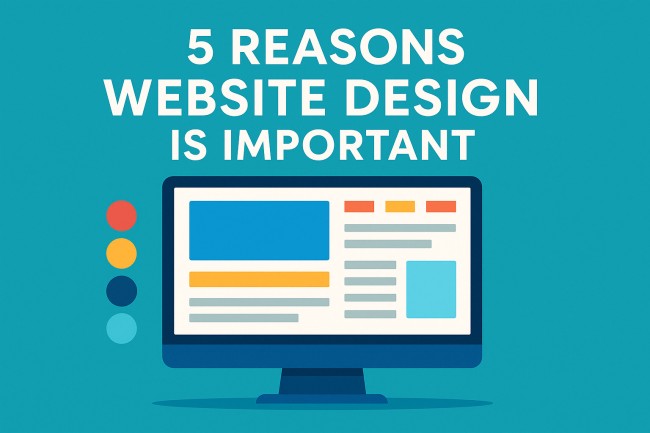
Did you know that the design of your website will either make or break your business? Most website experts will recommend a purely simple and plain web design. Yes, it is true.
But don’t neglect the idea that most people want something beautiful and pretty in their eyes. That is why you have to consider website design as one of the crucial factors for your website success.
Your online presence should go to a higher level if you want to attract more potential customers. The visibility of your brand website must be higher than your competitors. It means your site has to rank on the top page of the search engine results pages.
Why so? Because it is the only way for you to gain the so-called competitive advantage. So, how important is your website design to gaining a competitive advantage and eventually hit biz success?
1. First Impressions Forge Brand Credibility
A digital handshake lasts around fifty milliseconds, according to eye‑tracking studies. Presentation sets expectations before content has time to shine.
- Balanced spacing lowers cognitive load.
- Consistent logos and typography create instant recognition.
- Accessible color contrast welcomes every visitor, including those who rely on screen readers.
Clean grids whisper order. Sharp photography signals quality goods. Rough edges or clashing hues hint at poor service. Trust gained early halts high bounce rates and keeps readers exploring deeper. An old idiom says, “Fine feathers make fine birds,” and the same logic applies; refined pages lift brand stature on sight.
2. Smooth User Experience Extends Engagement
Visitors hunt for answers, not riddles. Navigation should feel like a well‑lit path, not a maze. When menus hide behind obscure labels or buttons sit too close together, frustration mounts.
Key elements for graceful journeys:
- Logical hierarchy: Home → Category → Article ensures short travel time.
- Predictable placement of calls‑to‑action: top right, middle of article, and footer.
- Readable line length: 50–75 characters promote effortless scanning.
- Generous white space: pauses the eye, highlights key points.
Heat‑map tools reveal that orderly pages entice longer sessions. Longer sessions raise dwell time—an engagement metric search engines treat as a signal of relevance. Higher relevance moves rankings upward, fueling a loop where user satisfaction and search visibility feed each other.
Fast loading levels the playing field. Every extra second of delay can cut conversions by up to 7 percent, according to Google’s own research.
Lazy loading of off‑screen images, compression of SVG icons, and HTTP/2 combine to slash wait times. Speed wins favor with visitors and algorithms alike.
3. Website Design Fuels Search Performance
Search crawlers behave like strict librarians; clear structure makes cataloging painless. Strong website design adopts semantic HTML so that crawlers parse intent without guesswork. Header tags (H1, H2…), descriptive alt text, and ordered lists mark content value in a language machines grasp.
Core Web Vitals form the cornerstone of modern ranking criteria. Largest Contentful Paint under 2.5 seconds, First Input Delay under 100 milliseconds, and Cumulative Layout Shift under 0.1 all depend on design choices. A minimalist hero section, optimized fonts, and responsive images keep scores low.
Checklist for design‑driven SEO wins
- Compress images with next‑gen formats such as WebP.
- Strip unused CSS and combine media queries.
- Serve assets through a content delivery network for global reach.
- Structure data with schema.org to earn rich snippets.
In return, higher crawl efficiency leads to deeper indexing, fewer soft 404s, and stronger search presence. Pages rise, impressions spike, and organic traffic snowballs.
4. Conversion‑Centered Layout Lifts Revenue
Aesthetics alone seldom push shoppers across the line. Layout must guide eyes, spark emotion, and ease hesitation. Strong design borrows from behavioral psychology to stack small nudges.
- Visual hierarchy puts the product image first, price second, benefits third.
- Contrasting buttons stand out like lighthouses on a dark shore.
- Micro‑copy near forms such as “No spam ever” calms privacy fears.
- Progress bar in checkout shrinks perceived effort.
Case studies by Baymard Institute reveal that streamlined forms can reclaim 35 percent of abandoned carts. A shift from twenty fields to seven often proves enough. Responsive layouts allow seamless switching between mobile and desktop, meeting customers where they stand.
Design affects perception of value, too. Luxury brands employ generous white space and muted tones; budget outlets use bright accents and lively fonts. Each choice signals price point before figures appear. Aligning layout with brand promise stops sticker shock and drives smoother transactions.
5. Flexible Design Future‑Proofs Growth
Digital tools evolve faster than seasons turn. A modular design system, built on reusable blocks and a living style guide, lets teams add features without tearing foundations apart.
Benefits of modularity:
- Rapid iteration on landing pages during campaign season.
- Consistent branding across microsites, apps, and print assets.
- Simpler A/B tests, since headers, footers, and content blocks swap in seconds.
Adopting responsive frameworks such as CSS Grid or Flexbox reduces technical debt down the road. Designers can slide new widgets into place while developers keep code lean. Brands poised for change outpace rivals stuck in yesterday’s templates.
Security follows suit. Regular theme updates patch vulnerabilities the moment they surface. An outdated design often hides outdated code, which hackers sniff out. Fresh layouts keep both reputation and customer data intact.
Conclusion
Website design does more than paint pixels; it shapes trust, performance, sales, and future growth in one swift stroke.
A welcoming interface creates instant confidence, streamlined journeys hold attention, structured code pleases search crawlers, conversion cues grow revenue, and modular foundations adapt with the market.
Each element interlocks like gears inside a finely tuned watch. Overlooking design means fighting uphill battles in traffic, engagement, and profit. Investing in strong website design secures a long‑term edge and lets any brand shine brighter on crowded search pages.
Also Read:
